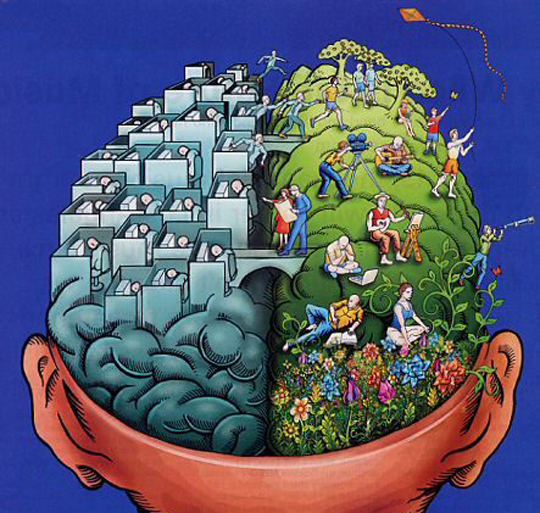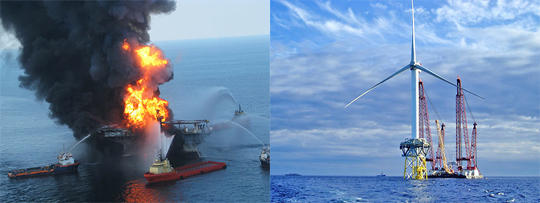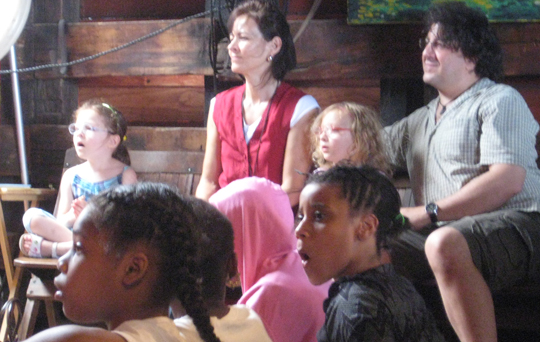
7 tips to get in the flow
You know the expression that begins, “I’ve got half a mind to. . . ?” Well, guess what? Most of us really are using only half our mind when tackling the tough challenges of greening our business. That’s the equivalent of trying to go three rounds with Mohammad Ali with one hand tied behind your back!
Yes, the focus of the green movement is almost exclusively on a linear, left-brain, problem-solving approach. Give things up, use less, eat your kale. While this has its place, it isn’t very inspiring. It is far more rewarding to engage our whole mind – including the often overlooked right brain.
I am more convinced than ever of the power of creative expression to catalyze new thinking. Brain science confirms this: we have two hemispheres, right and left. By holding only to the rational, linear, and analytical left brain, we treat the right brain as a poor step-child. We need to get over thinking of right-brain pursuits like art, photography, film, poetry, music, and storytelling as mere “entertainment.”
As Albert Einstein observed:
The intuitive mind is a sacred gift and the rational mind is a faithful servant. We have created a society that honors the servant and has forgotten the gift.
Relying only on the seen and rational, to the exclusion of engaged intuitive leaps, is one reason why more entrepreneurs aren’t already seeing the green in their own business. It also makes working sessions seem long, tedious, and – dare I say – boring. Since change is often challenging, using half our mind makes things way harder than they need to be!
I was reminded of this recently, working with a successful energy-efficiency consultancy to benchmark their sustainability practices. An early leader in the green building movement, they aspire to be a world-class company. It’s important to them to lead by example, and they want to focus their energies to do even better as they grow.
Our benchmark tool helped them to go deeper and look at operations, community engagement, and employee policies, as well as the more obvious impacts from energy use, transportation, and waste and recycling.
In our debrief after two sessions with them, we realized we had defaulted to a very left-brain focused, detailed, and exhausting mode. Luckily, these were engineers, so they weren’t fazed by the technical language and the linear, logical approach. Certainly, we all made plenty of discoveries and had a satisfying number of “a-ha” moments.
Still, we came away wondering what was left undiscovered. Next time we will structure the sessions very differently, to engage both left and right brains. Why can this help? Remember, our old friend Einstein said that imagination is more important than knowledge. We can get so dazzled by the facts and figures, by the data and the right-wrong mindset, that we can miss all the nuance.
Here are seven tips to making your next collaborative session more fun and productive. How can you open to new possibilities by honoring the gift of intuition this week?
1. No right or wrong. Start your session by reminding yourself and everyone that you are creating something new. You are not keeping score.
2. Be a beginner. Even if it’s something you do on a regular basis, think back to when you were brand new. How might a beginner approach the situation? What would a novice ask?
3. Tell a story. Our brains love analogies. A good story can be an economical – and inspiring – way to convey complex ideas and meaning.
4. Lighten up. Who says meetings have to be dull and serious? Laughter and play are inherently creative.
5. A picture is worth 1,000 words. Use images to help people brainstorm and make creative leaps. Pictures engage our right brain and help open us to greater possibility in the moment.
6. Roll up your sleeves. Rather than structuring a meeting with an expert up front giving everyone the Truth, get everyone around the table engaged. Invite them to get to work, rather than sit passively waiting for the answers.
7. Questions rather than answers. Encourage people to express their ideas only as questions and see what happens. Misunderstandings are treasure!
I’d love to hear your thoughts on this. How did this information help you? Post your comments below.






 View the dynamic, moving GOforChange: Greening Baltimore video
View the dynamic, moving GOforChange: Greening Baltimore video





